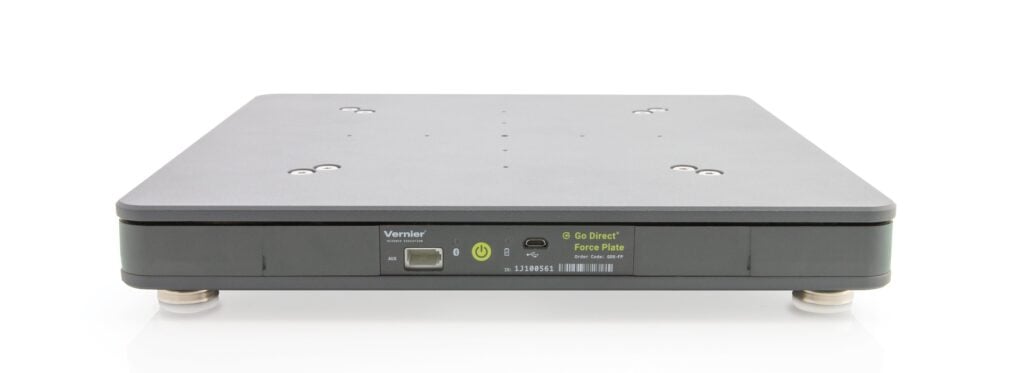Troubleshooting
General: Press the power button on the sensor to turn it on. Connect your sensor as described in the Getting Started instructions for your device.
- Primary Test: Using the default channel (Force), does the plate read approximately zero? Choose Zero in software. Stand on the plate; using F=mg, does the reading make sense?
- Secondary Test: Changing the physical orientation of the sensor will change the reading when no force is applied. Use the tools in the data-collection program to zero the sensor.
If the force plate does not respond to a change in force, try connecting the sensor using the alternate method (USB or Bluetooth). Verify that the battery is charged sufficiently. If plate still does not respond, contact Technical Support. Call 888-837-6437 or email support@vernier.com.
It is common for the force plate to exhibit some hysteresis (on the order of a few newtons) after hard impacts. This can be accounted for simply by zeroing the sensor.
Additional Troubleshooting
- What activities are available for the Force Plate?
- Can I use your equipment for a bridge-building contest?
- How short an impulse can I measure with the Force Plate?
- What does the Force Plate measure?
- Which force plate do I have?
- What is the AUX port and Auxiliary Voltage sensor channel used for on a Go Direct Force Plate?
- How do I switch between Physics and Physiology Sensor Channels on my Go Direct Force Plate?
- Why does my X Balance seem less stable than my Y Balance when using the Go Direct Force Plate?
- How do I use the X-axis and Y-axis Balance channels on a Go Direct Force Plate?
- Can you use a Force Plate with a Texas Instruments calculator?
- How do the Hang Time and Jump Height channels work on my Go Direct Force Plate?
- Lateral Force Accessory Troubleshooting and FAQs
- How should I calibrate my Force Plate?
- How do I set up my Ladder Experiment Kit?
Specifications
- Force range: -350 to +3500 N, where positive value is a compression force
- Maximum non-damaging compression force: 4500 N (1000 lb)
- Dimensions: 31.5 cm x 31.5 cm x 3.5 cm
- Connections:
⚬ Wireless: Bluetooth® v4.2 (wireless range 30 m unobstructed)
⚬ Wired: USB 2.0 full speed - Battery: 650 mAh Li-Poly
⚬ Battery Life (single, full charge): ~10 hours continuous data collection
⚬ Battery Life (lifetime): 2 – 5 years (typical)
Calibration
Calibrate? Generally, no. The sensor is set to the stored calibration before shipping. However, if your force plate readings are not consistent with expected readings, you may find calibration necessary. For more information, see How should I calibrate my Force Plate?
If you determine that calibration is needed to get accurate data from your force plate follow these tips:
- Do not exceed the selected range maximum force during calibration.
- The calibration weight should be at least 25% of the range (~25 kg or 50 lb).
- A person is not a good calibration mass as it is not easy to center their weight on the force plate.
- Take care to accurately center the weight on the force plate. The force reading combines 4 load cell signals; because of this, a calibration weight that is not centered significantly impacts the calibration.
Battery Troubleshooting
- If the sensor won’t turn when on its own, but does when connected to a USB power source, try charging the sensor for at least 2 hours using a known-to-work USB cable.
- If you continue to have trouble, try swapping the battery with a working sensor to see if the problem follows the battery or stays with the sensor.
⚬ If the problem stays with the sensor, the battery is probably not the issue.
⚬ If the problem follows the battery, the battery has likely reached its end of life. - If the battery is indeed at the end of its life, the battery should be replaced.
Go Direct® 650 mAh Replacement Battery (GDX-BAT-650 ) - See How do I remove or replace a Go Direct battery? for more information.
Rechargeable batteries are covered by a one-year warranty.
Batteries should last two to five years in typical use.
Related Products
- Micro USB to USB-C Cable (
CB-USB-C-MICRO ) - Go Direct® Charge Station (
GDX-CRG ) - Lateral Force Accessory (
2D-FP ) - Go Direct® 2-Axis Force Plate (
GDX-FP2D ) - Force Plate (
FP-BTA )
Replacement Parts
- Go Direct® 650 mAh Replacement Battery (
GDX-BAT-650 ) - Micro USB Cable (
CB-USB-MICRO ) - Force Plate Handles (
FP-HAN )

